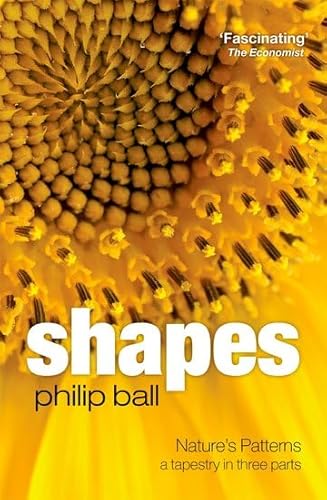Shapes: Nature's Patterns: A Tapestry in Three Parts
Ball, Philip
Librería:
GoldBooks, Denver, CO, Estados Unidos de America
Calificación del vendedor: 5 de 5 estrellas
![]()
Vendedor de AbeBooks desde 15 de mayo de 2019
Descripción
Descripción:
N° de ref. del artículo 87U86_45_019960486X
Sinopsis:
Patterns are everywhere in nature - in the ranks of clouds in the sky, the stripes of an angelfish, the arrangement of petals in flowers. Where does this order and regularity come from? It creates itself. The patterns we see come from self-organization. Whether living or non-living, scientists have found that there is a pattern-forming tendency inherent in the basic structure and processes of nature, so that from a few simple themes, and the repetition of simple rules, endless beautiful variations can arise.
Part of a trilogy of books exploring the science of patterns in nature, acclaimed science writer Philip Ball here looks at how shapes form. From soap bubbles to honeycombs, delicate shell patterns, and even the developing body parts of a complex animal like ourselves, he uncovers patterns in growth and form in all corners of the natural world, explains how these patterns are self-made, and why similar shapes and structures may be found in very different settings, orchestrated by nothing more than simple physical forces. This book will make you look at the world with fresh eyes, seeing order and form even in the places you'd least expect.
Acerca del autor: Philip Ball is a freelance writer and a consultant editor for Nature, where he previously worked as an editor for physical sciences. He is a regular commentator in the scientific and popular media on science and its interactions with art, history and culture. His ten books on scientific subjects include The Self-Made Tapestry: Pattern Formation in Nature, H2O: A Biography of Water, The Devil's Doctor: Paracelsus and the World of Renaissance Magic and Science, and Critical Mass: How One Thing Leads To Another, which won the 2005 Aventis Prize for Science Books. He was awarded the 2006 James T. Grady - James H. Stack award by the American Chemical Society for interpreting chemistry for the public. Philip studied chemistry at Oxford and holds a doctorate in physics from the University of Bristol. His latest book The Music Instinct published in February 2010.
Detalles bibliográficos
Título: Shapes: Nature's Patterns: A Tapestry in ...
Editorial: Oxford University Press, USA
Año de publicación: 2011
Encuadernación: Encuadernación de tapa blanda
Condición: new
Los mejores resultados en AbeBooks
Shapes: Nature's patterns: a tapestry in three parts
Librería: WorldofBooks, Goring-By-Sea, WS, Reino Unido
Paperback. Condición: Very Good. Patterns are everywhere in nature - in the ranks of clouds in the sky, the stripes of an angelfish, the arrangement of petals in flowers. Where does this order and regularity come from? It creates itself. The patterns we see come from self-organization. Whether living or non-living, scientists have found that there is a pattern-forming tendency inherent in the basic structure and processes of nature, so that from a few simple themes, and the repetition of simple rules, endless beautiful variations can arise. Part of a trilogy of books exploring the science of patterns in nature, acclaimed science writer Philip Ball here looks at how shapes form. From soap bubbles to honeycombs, delicate shell patterns, and even the developing body parts of a complex animal like ourselves, he uncovers patterns in growth and form in all corners of the natural world, explains how these patterns are self-made, and why similar shapes and structures may be found in very different settings, orchestrated by nothing more than simple physical forces. This book will make you look at the world with fresh eyes, seeing order and form even in the places you'd least expect. The book has been read, but is in excellent condition. Pages are intact and not marred by notes or highlighting. The spine remains undamaged. Nº de ref. del artículo: GOR003475560
Cantidad disponible: 3 disponibles
Shapes: Nature's Patterns: A Tapestry in Three Parts
Librería: GoldBooks, Denver, CO, Estados Unidos de America
Paperback. Condición: new. New Copy. Customer Service Guaranteed. Nº de ref. del artículo: 44O53_35_019960486X
Cantidad disponible: 1 disponibles

